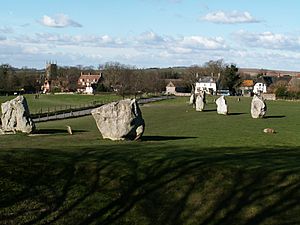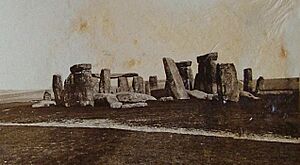John Aubrey facts for kids
Quick facts for kids
John Aubrey
|
|
|---|---|
 |
|
| Born | 12 March 1626 Kington St Michael, Wiltshire, England
|
| Died | 7 June 1697 (aged 71) |
| Resting place | St Mary Magdalen, Oxford |
| Nationality | English |
| Alma mater | Trinity College, Oxford |
| Occupation |
|
John Aubrey (born March 12, 1626 – died June 7, 1697) was an English historian, scientist, and writer. He is best known for his book Brief Lives. This book is a collection of short stories about different people.
John Aubrey was one of the first archaeologists. He found and wrote about many ancient stone circles and monuments in southern England. He is especially famous for studying the Avebury stone circle. The Aubrey holes at Stonehenge are named after him. He was also a pioneer folklorist. He collected information about old customs, traditions, and beliefs. He called this collection "Remaines of Gentilisme and Judaisme".
He tried to write histories of Wiltshire and Surrey counties, but he never finished them. His book "Interpretation of Villare Anglicanum" was the first to study English place-names in detail. He was also interested in math and astronomy. He was friends with many important scientists of his time.
For a long time, people thought Aubrey was just an entertaining but strange storyteller. But in the 1970s, people started to see how wide-ranging and new his ideas were. He didn't publish much during his life. Many of his important writings are still kept in the Bodleian Library. Most of them have not been published or are only partly published.
Contents
Early Life and Education
John Aubrey was born in Easton Piers, near Kington St Michael, Wiltshire. His family was wealthy and had lived there for a long time. His grandfather, Isaac Lyte, lived at Lytes Cary Manor, which is now owned by the National Trust. His father, Richard Aubrey, owned land in Wiltshire and Herefordshire.
John was an only child for many years and felt "melancholy" (sad) being alone. His father loved hunting more than reading. But John secretly read books, including Bacon's Essays, and studied geometry.
He went to grammar school in Malmesbury. His teacher, Robert Latimer, had also taught the famous philosopher Thomas Hobbes. Aubrey later met Hobbes at Latimer's house and wrote his biography. He also studied at a grammar school in Blandford Forum, Dorset.
In 1642, he started at Trinity College, Oxford. But his studies were stopped by the English Civil War. His first work on old things started during this time in Oxford. In 1646, he became a student at the Middle Temple. He enjoyed his time at Trinity in 1647, making friends and collecting books. He spent a lot of time in the countryside.
In 1649, he found the large stone remains at Avebury. He later mapped these and wrote about them in his important book Monumenta Britannica. In 1663, he showed Avebury to King Charles II when the King asked to see it. His father died in 1652. John inherited large estates, but also many complicated debts.
A Life of Discovery
John Aubrey said his memory was "not tenacious" (not very strong) for his time. But from the 1640s, he kept detailed notes. These notes were about science, his friends' ideas, and ancient things. He started writing short biographies of scientists in the 1650s.
In 1659, he was asked to help write a history of Wiltshire county. This led to his unfinished collections on the old things and natural history of the county. His friend, Anthony Wood, joked that Aubrey would break his neck rushing to interview people. Aubrey was a Royalist (supported the King) but also liked new ideas. He was sad about the destruction of old buildings during the Civil War.
In 1663, Aubrey became a member of the Royal Society. He lost many of his properties because of lawsuits. By 1670, he had lost his last property and family home, Easton Piers. After this, he relied on his many friends for a place to stay. Especially kind were Sir James Long, 2nd Baronet, and his wife Lady Dorothy.
In 1667, he met Anthony Wood in Oxford. When Wood started gathering information for his book Athenae Oxonienses, Aubrey offered to help. He sent Wood notes in a casual, letter-like style. In 1680, he promised to send his "Minutes for Lives" for Wood to use.
Later Years and Passing
John Aubrey died suddenly in June 1697, at age 71, while traveling. He was buried in the churchyard of St Mary Magdalen, Oxford.
How John Aubrey Wrote Biographies
Aubrey collected information like scientists collected items for museums. He gathered as much as he could. He often left the job of checking facts to Anthony Wood or to people in the future. He wrote his "Lives" early in the morning while his hosts were still asleep. He called these writings Schediasmata, meaning "pieces written on the spur of the moment".
He often left blank spaces for dates and facts, adding new information later. His notebooks had notes to himself, often saying "quaere" (Latin for "go and find out"). He valued what he saw with his own eyes the most. He made sure to note where people were buried and where their portraits and papers were.
People have sometimes said his work was not accurate. But Aubrey usually wrote exactly what he saw or heard. When he wrote down rumors, he was careful to say where he heard them from. For example, he wrote a story about Thomas Chaloner that turned out to be about someone else. Aubrey left the first story in his text but added a note in the margin to correct it.
John Aubrey's Books
Brief Lives: Stories of People
In 1680, Aubrey started his collection of short biographies, calling them "Schediasmata: Brief Lives". He gave them to Anthony Wood in 1681. But he kept working on them until 1693. Then he placed his writings in the Ashmolean Museum. They are now in the Bodleian Library.
Because these were private writings, they could contain interesting but controversial details. These details are what make them so important today. When he let Anthony Wood use them, Aubrey warned that much of the content was "not fitt to be let flie abroad" while the people and author were still alive.
Aubrey's relationship with Wood became difficult. Aubrey asked Wood to be his "index expurgatorius" (like a censor). Wood seemed to take this as permission to just copy pages into his own work. In 1692, Aubrey complained that Wood had cut up forty pages of his writing. Wood was later sued for some things he wrote. One of these was based on Aubrey's information. This might explain why they stopped being friends.
A large part of the "Lives" was published in 1813. A nearly complete version was edited by Andrew Clark in 1898. This was the main edition for many years. But it left out some parts for "decency." Later, more popular versions appeared, often including the parts Clark had removed. The most complete and scholarly edition, published in 2015, is by Kate Bennett.
Aubrey also wrote a longer biography of the philosopher Thomas Hobbes, called "The Life of Mr Thomas Hobbes of Malmesbury". This is a separate work, though often grouped with Brief Lives.
Monumenta Britannica: Ancient Sites
Monumenta Britannica was Aubrey's main collection of archaeological information. He worked on it for about thirty years, from 1663 to 1693. It has four parts:
- "Templa Druidum": This part discusses supposed "druidic" temples, especially Avebury and Stonehenge.
- "Chorographia Antiquaria": This is a survey of other old towns and military sites. It includes Roman towns, hillforts, and castles.
- A review of other archaeological remains. This includes tombs, roads, coins, and urns.
- More analytical pieces. These include attempts to map how handwriting, medieval buildings, clothes, and shield shapes changed over time. His essay on architecture, "Chronologia Architectonica", was very detailed. It is now seen as a very important step in understanding architectural history.
The original writings of Monumenta Britannica are in the Bodleian Library. Parts of it were published in 1980–82. However, this edition has been criticized for not being complete or accurate enough.
Wiltshire: A County's History
Aubrey started collecting information for a natural history and study of old things in Wiltshire in 1656. In 1659, a group of Wiltshire gentlemen decided to create a county history. Aubrey agreed to work on the northern part of the county.
He divided his work into two projects: one on old things (called Hypomnemata Antiquaria) and one on natural history. The work on old things was mostly finished by 1671. He put his draft in the Ashmolean Museum. Sadly, one of these volumes was lost later. He then started on the county's natural history. He shared some of his findings with the Royal Society. By 1690–91, he had a good copy of the natural history. In 1693, Aubrey asked his brother and Thomas Tanner to finish the project, but they could not.
The writings for the Naturall Historie are in the Bodleian Library. A copy made for the Royal Society has extra material. The surviving writings for the Antiquities are also in the Bodleian Library. Parts of these works have been published over the years.
Editions
- Jackson, John Edward, ed. (1862). Wiltshire: The Topographical Collections of John Aubrey, F.R.S., A.D. 1659–70, with Illustrations. Devizes: Wiltshire Archaeological and Natural History Society. https://archive.org/details/wiltshiretopogra00aubr/page/n12.
Perambulation of Surrey: Exploring a County
In 1673, John Ogilby, a mapmaker, asked Aubrey to survey Surrey. Aubrey did the work, but Ogilby's larger project was stopped. Aubrey kept adding to his writings until 1692.
His writings for this project are now in the Bodleian Library. A changed version was published in five volumes in 1718–19.
Remaines of Gentilisme and Judaisme: Old Beliefs
This book was Aubrey's collection of customs, traditions, ceremonies, beliefs, and old stories. Today, we would call this folklore. He worked on it for many years and wrote it up between 1687 and 1689.
The original writings are now in the British Library. An edition was published in 1881. A better version was edited in 1972.
Miscellanies: Strange Phenomena
The only book Aubrey published during his lifetime was his Miscellanies (1696). It was a collection of 21 short chapters about "hermetick philosophy" (supernatural things). This included "Omens", "Prophesies", "Transportation in the Air", and "Second-Sighted Persons". It mainly contained reports of supernatural events. This book made people think Aubrey was superstitious and strange after he died.
Other Writings
Aubrey's papers also included "Architectonica Sacra" and "Erin Is God" (notes on old church buildings).
His "Adversaria Physica" was a science notebook. It is now lost, but some copies of parts of it still exist.
He also wrote two plays, both comedies. The first one is lost. The second, "Countrey Revell", was never finished.
See also
 In Spanish: John Aubrey para niños
In Spanish: John Aubrey para niños



